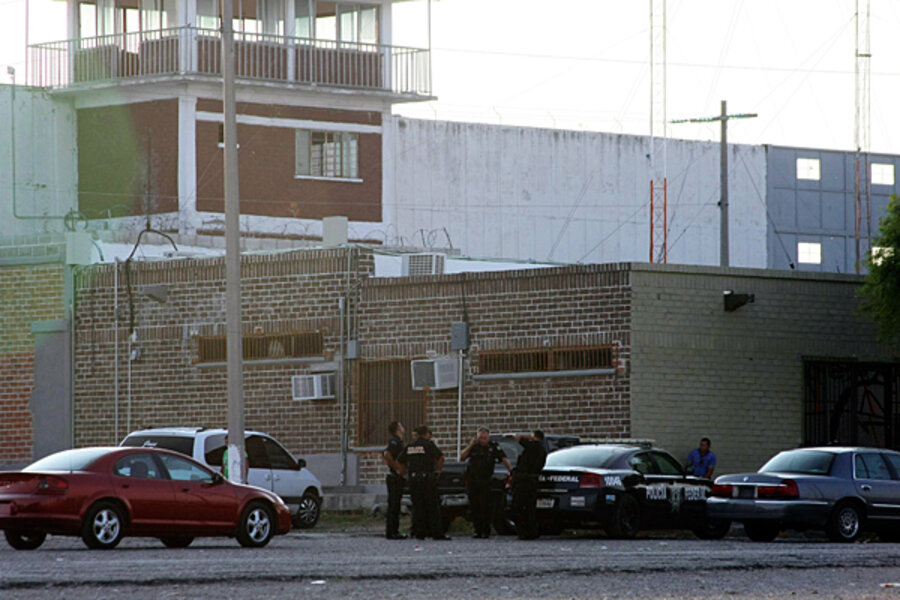Jailbreaks in Mexico: Wardens and guards often help drug cartel members flee
Loading...
| Mexico City
Needing to replenish its ranks, Mexico’s brutal Los Zetas crime gang has refined the tactic of springing hundreds of its members in mass jailbreaks. But unlike the Hollywood version, the jailbreaks don’t involve overcoming guards, crawling through dingy tunnels, and scattering once outside the fence. Instead, scores of dangerous inmates simply walk or drive out the gates in cahoots with wardens and prison guards.
The jailbreaks, including one this week in which 129 inmates fled a state prison near Piedras Negras, across from Eagle Pass, Texas, lay bare Mexico’s broken penitentiary system, where wardens either bend to organized crime or face death.
Prosecutors Wednesday arrested the warden, the security chief and 14 watchtower and cellblock guards for allegedly letting the prisoners escape on Monday.
A crude 23-foot-long tunnel was found in the prison’s woodworking shop leading outside the wall. But prosecutors say the tunnel was just a cover and that inmates walked out or were driven out of the prison in connivance with guards.
“It is impossible that they all left through the tunnel at once, as the [prison] authorities argue,” said Homero Ramos, the attorney general for the surrounding state of Coahuila. “They’d probably been leaving for days until this blew up and they couldn’t hide it anymore.”
“They definitely didn’t leave through the tunnel,” echoed Jorge Luis Moran, the state’s public security chief, adding that the escapees are believed to have gone to neighboring Tamaulipas state, a stronghold of Los Zetas.
Los Zetas have regained hundreds of gang members in jailbreaks in recent years. El Economista, a Mexico City newspaper, said it had reviewed prison records and found that 546 accused Zetas gangsters or sympathizers have gone free since May 2008.
“The risk is very low and the benefits are very high for Los Zetas,” said Alberto Islas, a security analyst at Risk Evaluation Inc., a Mexico City consulting firm. “You’re getting people out of jail who ... are already trained.
“This is a way for them to regain and reinforce their movement.”
Law enforcement authorities rarely recapture fugitive inmates. Four days after the Piedras Negras incident, agents have recaptured three of the fugitives, despite a reward equivalent to $15,500 each offered by the Coahuila state government.
One of those captured, Pablo Sanchez Campos, who was awaiting trial on robbery charges, told authorities that he saw other inmates leave through the prison’s main gate and decided to join them.
Analysts describe the situation in some of Mexico’s state and federal prisons as “self-government,” with inmates in charge and guards entering at their own risk.
In the Piedras Negras prison, said Raul Benitez Manaut, a political scientist at the National Autonomous University of Mexico, inmates “had total control” and had gained “the support of the guards and the warden.”
“It was really a center of operations for Los Zetas,” Benitez said.
The prison had no functioning closed-circuit television system, and unauthorized vehicles were seen entering the prison earlier Monday.
At least 23 significant prison breaks have occurred since President Felipe Calderon came to office in late 2006. All have been at state prisons.
Monday’s was the largest jailbreak since 141 inmates broke out of the prison in Nuevo Laredo on Dec. 17, 2010.
Serving as prison warden is one of the most dangerous jobs in Mexico, and numerous wardens have either been assassinated or bent to the will of gangsters.
In the past two years, hit squads have killed prison wardens in Hermosillo (Jan. 3, 2011), Nuevo Laredo (March 15, 2011), Lazaro Cardenas (March 18, 2011) and Saltillo (Dec. 13, 2011), as well as slaying family members of wardens in several other cities.
A month ago, the warden of a prison in Zacatecas, Fabiola Quiroz Zarate, ordered the transfer of dozens of dangerous inmates to other jails. A day later, gunmen broke into her house and kidnapped her and two family members. Neither the 43-year-old Quiroz nor her family members have been seen since.
Unable to bear the threats, or enticed by bribes, or both, some wardens go to the dark side. Perhaps the most extreme case occurred in July 2010, when prosecutors said a prison warden in Durango state allowed inmates to go free at night, handed over weapons and official vehicles and allowed them to carry out three contract killings that left 35 people dead.
Claudia Rodriguez, a columnist for the Quadratin digital news website, wrote Thursday that events this week “reveal to us and confirm that prisons rehabilitate criminals by day while at night they are allowed to leave and, without doubt, are even given guns so they can be paid killers.”
Benitez said the faltering penitentiary system would be one of President-elect Enrique Pena Nieto’s challenges when he takes office Dec. 1.
Since federal prisons cannot hold all those charged with federal crimes related to drug trafficking, thousands of dangerous inmates are handed down for incarceration in less-secure state prisons, he said.
The lax security is evident in periodic news reports about jails with cellblocks equipped with cantinas and apartments with creature comforts.
“Cellphones, prostitutes, drugs, plasma TVs, you name it. If you have enough money, you can live inside the prison as you would outside the prison,” Islas said.







